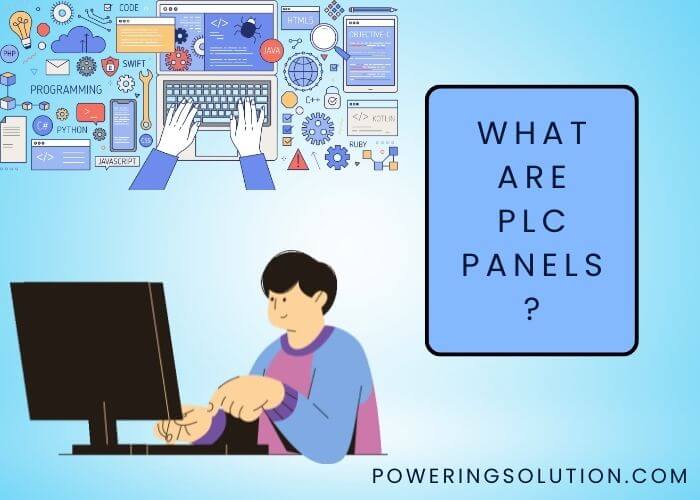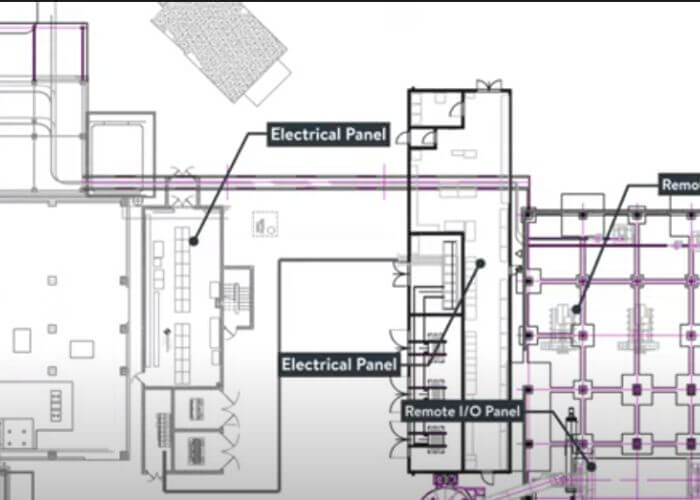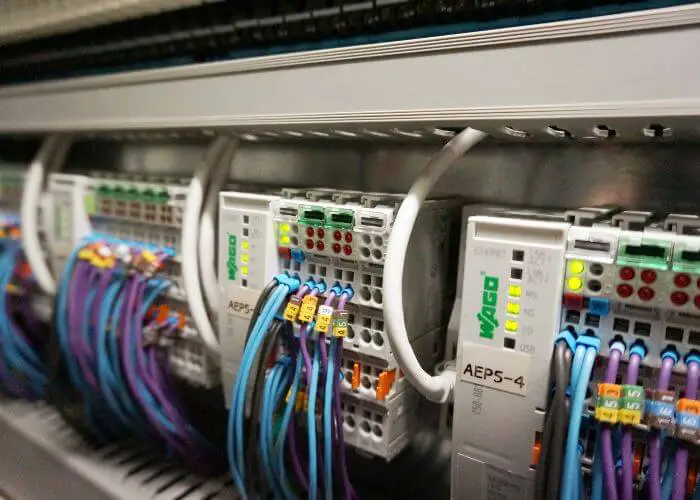PLC panels are used in a variety of industries and applications as a means of monitoring and controlling process variables. Also known as Programmable Logic Controllers, these devices typically have a central processing unit (CPU), input/output (I/O) modules, and various other supporting components such as power supplies and communication ports.

PLCs can control anything from simple processes to complex industrial machinery.PLC panels are an essential component of any industrial or commercial facility. They provide the means to control and monitor the various systems and equipment within the facility. Without a PLC panel, it would be challenging to properly manage and maintain a safe and efficient operation.
PLC Panel Full Form
PLC is an acronym for programmable logic controller. A PLC is a computer used to control machinery in an industrial setting. They are commonly used in manufacturing plants and process plants.
A PLC panel is a device that houses one or more programmable logic controllers (PLCs). The panel provides power, I/O connections, and environmental protection for the enclosed PLC(s).
PLC Control Panel Specification
When it comes to specifying a PLC control panel, many factors need to be considered:
First Step
The most crucial factor is the application or process that the panel will be controlling. This will dictate the type of PLC and I/O that is required. Other factors include the environment in which the panel will be installed, power requirements, and any special features that may be needed.
Second Step
Once the application and associated requirements have been determined, the next step is to select a PLC manufacturer. There are many different manufacturers to choose from, each with its own strengths and weaknesses.
It is important to select a manufacturer with experience with similar applications and who can provide a robust solution.
Third Step
After the manufacturer has been selected, it is time to specify the actual PLC control panel. This includes specifying the enclosure, I/O modules, power supply, etc.
Once again, it is important to ensure that all components are compatible with one another and meet the application’s specific requirements.
Final Step
Once all of these factors have been considered and specified, it is time to install and commission the PLC control panel. This process ensures that everything is properly connected and functioning as intended before putting it into operation.
Following these steps will result in a successful installation and ensure years of reliable operation.
Industrial PLC Control Panel
An Industrial PLC Control Panel is a centralised system that monitors and controls all the machinery in an industrial facility. It is the nerve centre of the factory, and all decisions regarding production flow, quality control, and safety are made here. The panel usually consists of a large touchscreen display with various buttons and knobs to control the factory floor’s different aspects.
The PLC Control Panel is connected to every machine on the factory floor via a network of sensors and actuators. These devices send information to the panel about the current state of each machine and receive instructions from the panel on what actions to take. This allows the operator to see what is happening on the floor and makes it easy to change the production process if necessary.
The PLC Control Panel is an essential piece of equipment in any modern industrial facility and can be used to improve efficiency and reduce downtime.
Electrical Control Panel
An electrical control panel is a device that controls and monitors the operation of an electrical system. It is typically used in industrial and commercial applications. The control panel typically contains a variety of devices, such as switches, circuit breakers, contactors, and relays.
These devices are connected to the electrical system and allow the operator to control and monitor the system’s operation.
PLC Panel Components

PLC Panel Components Most PLC panels consist of three main sections: the input, output, and power supply. Field devices are connected to the PLC in the input and output sections.
These could be sensors, actuators, or other types of field devices. The power supply provides power to the PLC and typically includes a backup battery in case of power outages. The input section converts incoming signals from field devices into a format that the PLC’s CPU can read.
This usually involves optoisolators isolating the inputs from the rest of the panel electrically. The outputs section does the opposite, converting signals from the PLC’s CPU into a format that field devices can use. One field device often connected to a PLC is a programmable logic controller (PLC) keypad or operator interface unit (OIU).
This allows an operator to interact with the PLC, view status information, and change settings as needed. Other standard peripherals include data storage devices such as USB flash drives, printers, and modems.
Electrical Control Panel Components List
An electrical control panel is a power distribution system that controls electric motors, lighting systems, and other equipment in an industrial facility. It typically comprises the main breaker, fuses, circuit breakers, and other switchgear.
The following is a list of standard components found in an electrical control panel:
| Main breaker | The main breaker is the primary switching device in the panel. It is used to disconnect the entire system from the power source. |
| Fuses | Fuses are used to protect circuits from excessive currents. They are usually located near the main breaker or at the point where each circuit originates. |
| Circuit breakers | Circuit breakers protect against overloads and short circuits. They are typically located throughout the panel for easy access. |
| Other switchgear | Other switchgear, such as contactors and relays, may be present in the panel to control specific loads or processes. |
Automation Panel

An automation panel is a device that allows a user to control various aspects of a machine or process. Automation panels can control machinery’s speed, direction, and other aspects. They are often used in industrial and other settings such as homes and office buildings.
How Many Types of PLC Panels Are There?
When it comes to PLC panels, three types are most commonly used. These include the standard, mini, and micro PLC panels. Standard PLC panels are the largest of the three and typically accommodate up to 48 I/O modules.
Mini PLC panels are smaller and typically accommodate up to 24 I/O modules. Micro PLC panels are the smallest of the three and can typically accommodate 12 I/O modules.
What Does PLC Stand For?
PLC is an acronym for Programmable Logic Controller. A PLC is a computer used to control industrial machinery and processes. It can be programmed to perform various tasks, such as turning on and off lights or motors, opening, and closing valves, monitoring sensors, etc.
PLCs are often used in industrial applications where reliability and ruggedness are required, such as in manufacturing plants or oil refineries. They are also used in more simple applications, such as controlling the lighting in a building.
What Are the Components of the PLC Panel?
PLC panels are one of the most important components in any automated industrial process. They provide the user interface between the programmable logic controller (PLC) and the outside world. A typical PLC panel includes a power supply, an input/output (I/O) section, a central processing unit (CPU), and various indicator lights.
The power supply provides the electricity needed to run the PLC panel components. The I/O section is where sensors and actuators are connected to the PLC. The CPU is responsible for executing the instructions stored in the PLC’s memory.
Finally, indicator lights are used to indicate when certain events happen or to provide diagnostic information.
What Are the 3 Types of PLC?
A PLC, or programmable logic controller, is a computer used to control industrial machinery. There are three main types of PLCs: basic, mid-range, and high-end.
- Basic PLCs are the most affordable and have the simplest features.
- Mid-range PLCs are more expensive but have more features, such as greater memory capacity and higher processing speed.
- High-end PLCs are expensive but offer the most advanced features, such as Ethernet connectivity and support for multiple programming languages.
Wrap Up
A PLC panel is a control panel used to operate machinery in an industrial setting. PLC panels typically contain input and output devices and a central processing unit (CPU) that controls the entire system’s operation.
References: